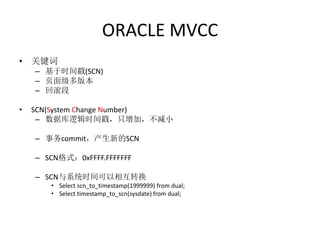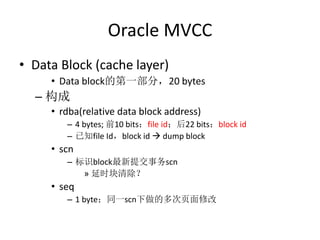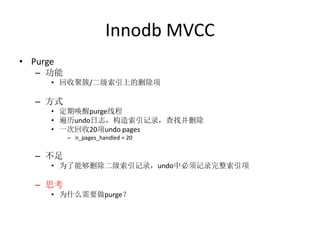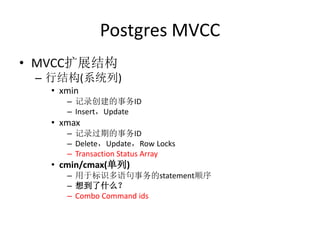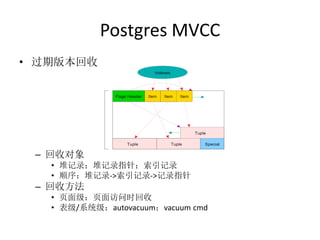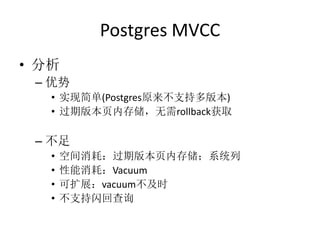Mvcc (oracle, innodb, postgres)
- 1. MVCC(Oracle/Innodb/PG) 网易杭研院——何登成
- 2. Outline • MVCC介绍 • MVCC实现 – Oracle – InnoDB – PostgreSQL • 总结
- 3. MVCC简介 • 何谓MVCC – 多版本并发控制(MultiVersion Concurrency Control) • MVCC的优势 – 高并发 • 读写不相互阻塞(读可见版本) • 不同数据库的可见版本定义? – 低加锁开销 • 读不加锁 • OLTP应用,8(read)/2(write) • 支持MVCC数据库 – 现阶段几乎所有主流数据库 – Oracle, DB2(since 9.7), SQL Server(since 2005), Mysql Innodb, Postgres …
- 4. MVCC实现 • 实现方式 – 基于时间戳 • Oracle – 基于事务ID • Innodb,Postgres • 实现粒度 – 页面级多版本 • Oracle – 行级多版本 • Innodb,Postgres
- 5. ORACLE MVCC • 关键词 – 基于时间戳(SCN) – 页面级多版本 – 回滚段 • SCN(System Change Number) – 数据库逻辑时间戳,只增加,不减小 – 事务commit,产生新的SCN – SCN格式:0xFFFF.FFFFFFF – SCN与系统时间可以相互转换 • Select scn_to_timestamp(1999999) from dual; • Select timestamp_to_scn(sysdate) from dual;
- 6. Oracle MVCC • 页面级多版本 – 回滚段(rollback segment) • 修改记录,记录的前镜像(undo)写入回滚段 • 记录的旧版本,通过读取回滚段,获得undo,回滚获得 – 页面级SCN • 页头结构中,当前页面最新提交事务的SCN (非确切说法) • 延时块清除(Deferred Block Cleanout) • Row Level SCN? – 页面级Undo • 将页面回滚到可见版本(非记录)
- 7. Oracle MVCC • 可见性判断 – 给定查询SCN,回滚页面获得可见CR Block (Consistent Read:一致读) 1. CR Block的SCN小于查询SCN 2. CR Block上无活跃事务
- 9. Oracle MVCC • Data Block (cache layer) • Data block的第一部分,20 bytes – 构成 • rdba(relative data block address) – 4 bytes; 前10 bits:file id;后22 bits:block id – 已知file Id,block id dump block • scn – 标识block最新提交事务scn » 延时块清除? • seq – 1 byte;同一scn下做的多次页面修改
- 10. Oracle MVCC • Data Block (transaction layer) – Fixed部分 • ITL数量(页面并发事务数) – INITRANS;MAXTRANS • 空闲页锁 • Freelist指针 • CSC:cleanout scn – Variable部分 • ITLs(Interested Transaction List) • 啊
- 11. Oracle MVCC • Data Block (Data layer) – Table directory • 聚簇表(cluster)? 作用? – Row directory • 行目录 – Row data • 行数据
- 12. Oracle MVCC • Row Format – tl: total length – fb: flag byte • 行类型 • KCHDFLPN – lb: lock byte • ITL number – cc: column count • NULL?
- 14. Oracle MVCC • 回滚段 & 事务 – 事务ID • 8 bytes xid: 0x0004.00e.0000449b • 0004: 回滚段号 • 00e: 回滚段中的事务slot号 • 0000449b: 事务槽被重用的次数
- 15. Oracle MVCC • 块清除(Block Cleanout) – 清除什么? • 清除数据块上的事务操作:行锁;ITL;设置CSC;Block SCN ... – 何时清除 • fast block cleanout – 记录修改块,提交时清除 – 数量?Cache?日志? • deferred block cleanout(延时块清除) – 正确性保证:commit时更新回滚段头事务表 – 操作:等待下次事务型操作(why?)访问此块 – 为什么需要清除 • 不清除时怎么做?
- 16. Oracle MVCC • Undo – Block Undo • read current block • clone • read ITL • undo transaction – Consistent Read (CR读) • 将block上所有提交scn > query scn的事务undo – Ora-01555 • snapshot too old ? • undo_retention = 10800 ?
- 17. Oracle MVCC • 分析 – 优势 • 页面中不保存版本信息 • 支持闪回查询 – select count(*) from flashback_query_test as of timestamp to_timestamp('20011-11-17 13:34:12', 'yyyy-mm-dd hh24:mi:ss'); – 缺点 • 页面级别多版本,访问冲突 • 著名的ora-01555! – 大表的全表扫描处理:并行查询 – select /* +parallel (t1 8) */ * from huge_table t1;
- 18. Innodb MVCC • 关键词 – 基于事务ID – 行级多版本 – 回滚段 • 事务ID – 唯一标识一个事务 – 递增产生 • 新事务,对应更大的事务ID – 64位,8 bytes
- 19. Innodb MVCC • MVCC扩展结构 – 聚簇索引(主键索引) • 记录扩展(系统列) – DB_TRX_ID – ROLLBACK_PTR – Delete_Bit – 二级索引(辅助索引) • 记录扩展 – Delete_Bit • 页面扩展 – DB_MAX_ID » 作用?Index only scan
- 20. Innodb MVCC • 更新处理 – Delete • 聚簇索引 – 设置Delete_Bit位,前项写入回滚段 – 前项包括:系统列,二级索引属性列 • 二级索引 – 设置Delete_Bit位 – Update • 聚簇索引 – 原地更新,前项写入回滚段 • 二级索引 – clone & update,原项设置Delete_Bit (不物理删除)
- 21. Innodb MVCC • 可见性判断 – 原理 • 给定事务Tx,所有在事务Tx开始时已经提交的事务 做的更新是可见的(snapshot read) – ReadView • 每个事务,都有read_view结构,通过此判断可见性 • low_limit_id: 事务id >= 的所做的修改,均不可见 • up_limit_id: 事务id < 的所做的修改,一定可见 • trx_ids: 事务开始时,活跃事务链表
- 22. Innodb MVCC • Undo – 事务Undo • insert_undo链表 • update_undo链表 – 可见版本构造(记录级) 1. read 最新版本,判断可见性 2. 根据ROLLBACK_PTR回滚到前一版本 3. 继续步骤1
- 23. Innodb MVCC • Purge – 功能 • 回收聚簇/二级索引上的删除项 – 方式 • 定期唤醒purge线程 • 遍历undo日志,构造索引记录,查找并删除 • 一次回收20项undo pages – n_pages_handled = 20 – 不足 • 为了能够删除二级索引记录,undo中必须记录完整索引项 – 思考 • 为什么需要做purge?
- 24. Innodb MVCC • 分析 – 优势 • 实现简单(相对于Oracle) • 行级多版本,不存在false violation – 缺点 • 记录开销增加(系统列) • 记录不能实时物理删除(行标识) • 更新时,undo中需要记录二级索引所有属性 • purge性能较差 – 过期版本不能及时回收 – undo日志不能被覆盖 • 不支持闪回查询
- 25. Postgres MVCC • 关键词 – 基于事务ID – 行级多版本 – 无回滚段,行内存储 • 一次update操作,产生记录的两个版本 • 两个版本,都存储于页面内部
- 26. Postgres MVCC • MVCC扩展结构 – 行结构(系统列) • xmin – 记录创建的事务ID – Insert,Update • xmax – 记录过期的事务ID – Delete,Update,Row Locks – Transaction Status Array • cmin/cmax(单列) – 用于标识多语句事务的statement顺序 – 想到了什么? – Combo Command ids
- 27. Postgres MVCC • xmin/xmax – insert – delete – update – row lock
- 29. Postgres MVCC • Transaction Status Array – 事务数组,记录事务状态 – why need? • 行事务信息不清理 • Combo Command Id – cmin/cmax是单列 – 如何处理同一事务同时Insert/Delete多行? • 此时既需要cmin,又需要cmax
- 30. Postgres MVCC • 可见性判断 PostgreSQL 9.1.1 src/backend/utils/time/tqual.c
- 31. Postgres MVCC • 过期版本回收 – 回收对象 • 堆记录;堆记录指针;索引记录 • 顺序:堆记录->索引记录->记录指针 – 回收方法 • 页面级:页面访问时回收 • 表级/系统级:autovacuum;vacuum cmd
- 32. Postgres MVCC • 分析 – 优势 • 实现简单(Postgres原来不支持多版本) • 过期版本页内存储,无需rollback获取 – 不足 • 空间消耗:过期版本页内存储;系统列 • 性能消耗:Vacuum • 可扩展:vacuum不及时 • 不支持闪回查询
- 33. MVCC总结 • 时间戳 vs 事务ID • 回滚段 vs 页内存储 • 可见性判断 • 过期版本回收 • 闪回查询
- 34. Q&A
- 35. 谢谢大家




